Update to this topic: The Ten Brightest Stars (and where they are, with video) – 1. Arcturus
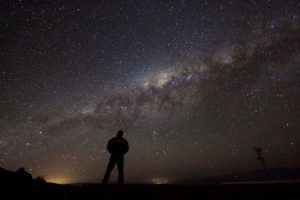
With city lights in the distance, a man stands, looking up at the Milky Way and the Galactic Center.
Going out to look up at the stars on a clear, dark night can be daunting, if not for its beauty and majesty but for what may seem like an uncountable number of stars; you often hear the comment “there are millions” of stars”! Indeed, there are quite a few more than mere “millions”; there are approximately 1022 ( 1 followed by 22 zeros) stars in the universe! Of those how many can we mere mortals see on a given night? Of those 1022 stars, there are about 250 billion in our Milky Way galaxy and of those, about half are forever invisible from earth, being located on the other side of the galaxy. The question then becomes, of those 125 billion or so stars accessible by observes on Earth, how many can we see with the smallest and simplest of optical instruments at our disposal, our eyes?
Astronomer Dorrit Hoffleit of Yale University compiled the Yale Bright Star Catalog decades ago. It includes every star visible from Earth to magnitude 6.5, the naked eye limit for most of humanity. This limit is biologically determined by the maximum size the eye’s pupil can dilate, about 0.5 cm on average (a bit smaller than a ¼ inch); that’s why astronomers keep building larger and larger telescopes since the greater the telescope’s diameter (aperture), the more light is collected and thus, the fainter we can see. Dr. Hoffleit determined that there are 9,096 stars over the entire sky, between the Northern and Southern hemispheres, within the magnitude 6.5 human-eye limit.
Now, getting back to our question; for a moment, lets transport ourselves to the middle of a remote desert, 100s of kilometers from the nearest lights, malls, streetlights and car dealerships. At that moment, you would be able to see approximately (9,096/2) or 4,548 stars.
Of those 9,096 stars, what are the five brightest ones and where are they? A companion question follows: why are they bright; is it because they’re relatively close or is it because they are intrinsically (in, and of themselves) powerful? Of the 9,096 stars, the sun may not have been included because of context; after all, Dr. Hoffleit was building a list of stars visible under the best observing conditions at night. So, our list of the six brightest stars in the sky (including the sun), in order of decreasing brightness, is:
1. The sun, located 1 Astronomical Unit (150 Million Km) from the Earth as our solar system’s principle governing mass and source of energy. Event thought it is brilliant in our sky here on Earth, as stars go, the sun is a relative piker in terms of intrinsic power and brightness and would be only about one magnitude brighter than the 6.5 magnitude human-eye threshold at a distance of 33 light years (one light year is the distance traveled by a beam of light in one year, about 9.5 trillion Kms, 5.9 trillion mi; 32.6 light years is the standard benchmark used by astronomers to compare all stars in terms of intrinsic brightness). Compared to other stars’ distances in terms of light travel time, the sun is 8.3 light-minutes distant.
2. Sirius, the brightest appearing star in both the Northern and Southern hemispheres, is located in the Northern hemisphere Winter sky (December in the Southern hemisphere is their summer) in the constellation Canis Major (the Great Dog). It is only 8.7 light years distant and is significantly more powerful than the sun in terms of intrinsic brightness but is a long way from the class of stars that are truly monsters in terms of their absolute intrinsic power.
3. The next on our list and the second brightest star in the sky after the sun and Sirius, is Canopus or Alpha Carinae, the brightest star in the Southern constellation Carina. Although the star skirts the horizon at 35º N latitude, the bulk of Carina, the Keel (of a ship-Latin; it was formerly part of the larger constellation Argo Navis) is best seen south of the Equator. Canopus is 36º directly south of Sirius in the sky and if you have a clear southern horizon and live at or south of 35º N latitude, you will be able to see Canopus. There is good reason why this star occupies the number two spot after Sirius; it is one of those monster stars alluded to above. Canopus is an evolved, giant star that is fusing helium in its core to produce energy and, at 10 times the mass of the sun, is on track to end its life in a spectacular manner as a Type II supernova. At 71 times the sun’s radius, the planet Mercury would almost orbit inside Canopus and, at 15,000 times the sun’s intrinsic luminosity (brightness across all colors and wavebands), it would appear brighter than Venus at full brightness but at 33 light years, a distance where the sun would be barely visible to the human eye under the darkest sky conditions! Its brightness is principally due to its enormous size.
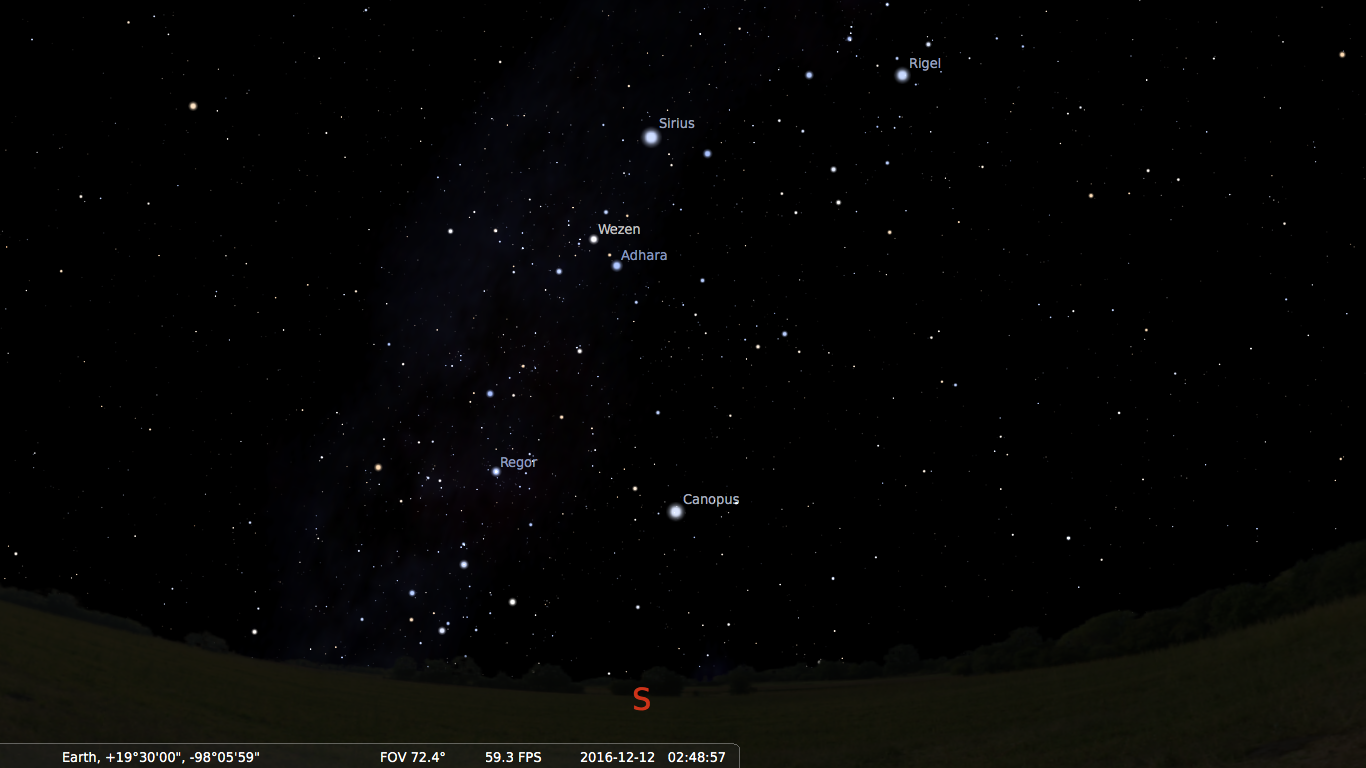
View to the south during mid-December from southern Mexico showing the location of Canopus relative to Sirius. View via Stellarium.
4. The next on our list and the fourth brightest star in the sky is Rigel Kentarus or Alpha Centauri. Alpha Centauri is a multiple-star system, with its two main stars Alpha Centauri A (α Cen A) and Alpha Centauri B (α Cen B), usually defined to identify them as the different components of the binary system, α Cen AB. A third companion, Proxima Centauri (Proxima or α Cen C) has a distance much greater than the observed separation of stars A and B and is probably gravitationally associated with the AB system. This star system is the closest to our solar system at 4.3 light years distance with Proxima, technically, the closest due to its current position in its orbit during this epoch in history. α Cen A is essentially the sun’s twin, being almost identical in just about every aspect to the sun. Its proximity combined with the light of α Cen B, a star slightly less luminous than the sun, are the principal reasons for it owning the distinction of “fourth brightest star in the sky”. The constellation Centaurus is generally considered to be a Southern hemisphere constellation with Rigel Kent below the horizon for any location north of Key West, Florida or central Mexico.
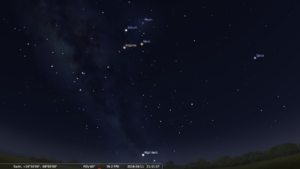
A view to the south from southern Mexico tonight shows familiar Antares with Scorpius higher in sky with Rigel Kentaurus skirting the southern horizon. View via Stellarium.
5. The next on our list, the fifth brightest star in the sky including the sun and the third brightest star in the sky after Sirius, is the beautiful red giant star Arcturus or α Boötis, the brightest star in Boötis, the herdsman. Arcturus is a circumpolar star (always above the Northern horizon for Northern latitudes) for latitudes above 70º N and remains prominent as a beautiful red-orange ruby set against the night sky for much of the year for mid-northern latitudes. Arcturus’s placement as number 5 on our list at 170 times the sun’s luminosity is due to its relative proximity of 37 light years and size of 25 times the sun. Having formed about three billion years before the sun, Arcturus is a very old star with an age over seven billion years. It is an evolved red giant star and was once very much like our sun and represents now what the sun will become some day in far distant future when its compliment of hydrogen runs down and it starts using the helium built up over billions of years as fuel.
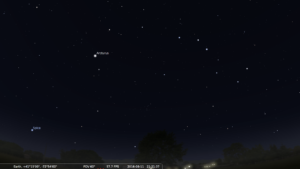
View towards the Northwest illustrating Arcturus with the familiar asterism known as the “Big Dipper” to the East. View via Stellarium.
6. The next and last star on our list, the sixth brightest star in the sky and the fifth brightest excluding the sun, is the “Contact” star, Vega or α Lyrae, the brightest star in Lyra, the celestial harp. As the destination in a futuristic journey through time and space by Dr. Eleanor Arroway (Jodie Foster) in the now famous, Hollywood feature-length movie Contact, Vega is “only” 25 light years distance, an important factor that contributes to its apparent brightness. Both Vega and Sirius are both of a similar stellar type, a factor that contributes to their blue-white color temperature and life expectancy. Both the sun and Vega are at about the mid-point along their evolutionary track (they’re both “middle aged”) but, because Vega is over twice the sun’s mass, it will have only about 10% of the sun’s lifespan. In another 500 million years, Vega will have depleted most of its compliment of hydrogen and begin to swell to become a red giant star such as Arcturus. Like Sirius, Vega’s apparent brightness is attributable, in large part, to its relative proximity to us. It is interesting to point out also that Vega, due to the Earth’s processional “wobble”, was the north pole star around 12,000 BC and will be so again around the year 13,727. It is a circumpolar star for all latitudes north of 51º N latitude and is prominently placed throughout most of the night between the months of April and November for all locations in the Northern Hemisphere. It is famously one of the three stars that comprise the “Summer Triangle”, Vega, Deneb and Altair.
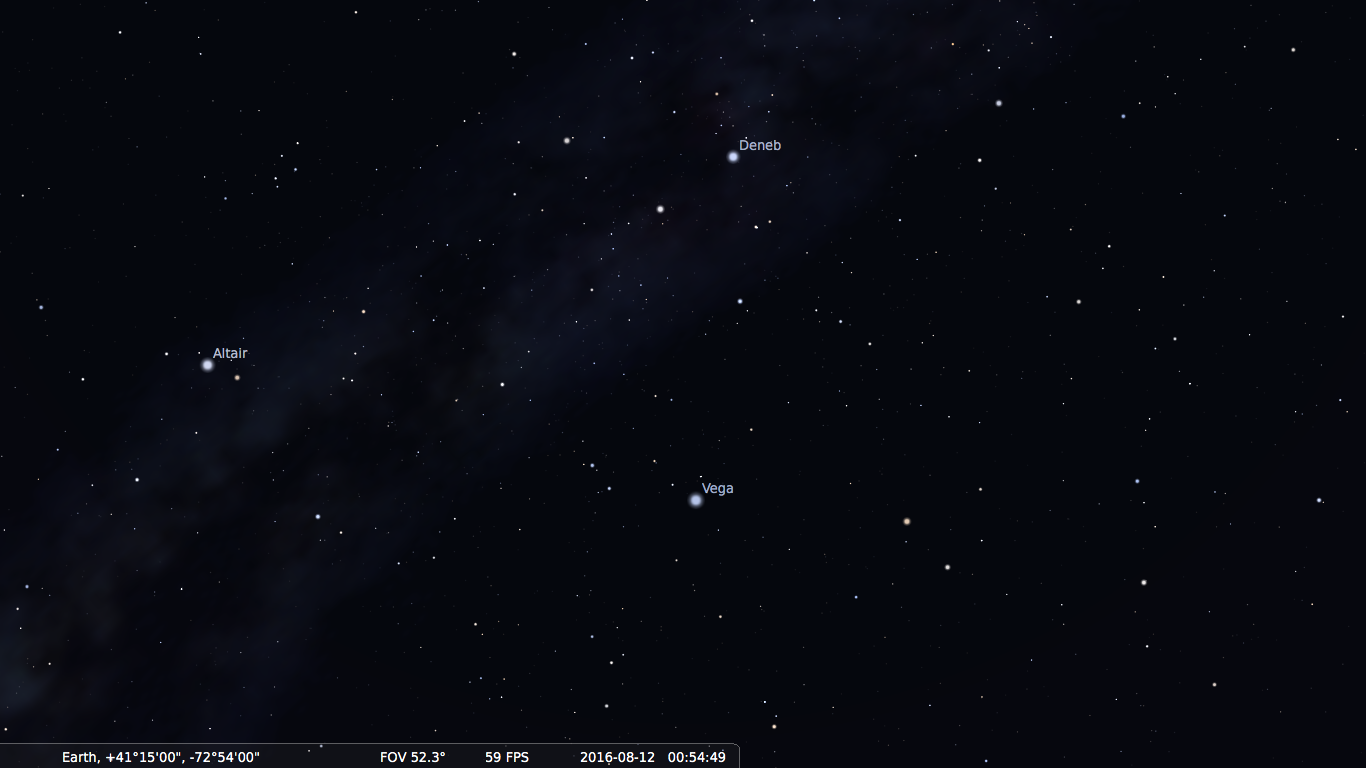
A view towards the zenith illustrating the Summer Triangle, consisting of Vega, Deneb, the tail of Cygnus, the Swan and Altair, the Crown of Aquila, the Eagle. View via Stellarium.
 And just when you thought stars couldn’t get any bigger with Arcturus, consider Antares, α Scorpii, the brightest star in Scorpio and the heart of the mythological scorpion. Although Antares doesn’t make the “Top Five”, it is noteworthy in its ruddy red color, its enormous size and placement during the summer early evening. To get a sense of its position on the sky, have a look at the Stellarium graphic accompanying number 4, above, Rigel Kentarus. At 883 solar radii, the planet Mars would orbit inside the red supergiant star! Like Arcturus, Antares is an evolved star, albeit mush further along its evolutionary track than Arcturus and much more massive, approximately 12.4 solar masses compared to Arcturus’ 1.1 solar masses. Unlike Arcturus but like Canopus, Antares will end its life in a spectacular manner as a Type II supernova.
And just when you thought stars couldn’t get any bigger with Arcturus, consider Antares, α Scorpii, the brightest star in Scorpio and the heart of the mythological scorpion. Although Antares doesn’t make the “Top Five”, it is noteworthy in its ruddy red color, its enormous size and placement during the summer early evening. To get a sense of its position on the sky, have a look at the Stellarium graphic accompanying number 4, above, Rigel Kentarus. At 883 solar radii, the planet Mars would orbit inside the red supergiant star! Like Arcturus, Antares is an evolved star, albeit mush further along its evolutionary track than Arcturus and much more massive, approximately 12.4 solar masses compared to Arcturus’ 1.1 solar masses. Unlike Arcturus but like Canopus, Antares will end its life in a spectacular manner as a Type II supernova.
I would like to take this opportunity to mention Stellarium, the free digital planetarium for your desktop, mobile phone or tablet. It was used to produce some of the graphics in this article and is used regularly in the development of content for this website. It is completely portable, scalable and versatile and is an aid to both the professional Astronomer and the novice alike. Its easy to use and setup, its great for the beginner and makes a great companion for students, instructors, teachers, professors and the seasoned observer alike and we wholeheartedly endorse it and recommend its use.
Free digital planetarium for your desktop
Featured image: Adaptive optics laser in operation as one of four 8-meter telescopes in the VLT array, Paranal, observes an object in the Galactic Center.












He ranked the stars he could see in terms of their brightness, with 1 representing the brightest down to 6 representing the faintest.
Yes, that is correct. A magnitude 1 star is 100x brighter than a magnitude 6 star. However, the magnitude scale is theoretically unlimited in terms of what is considered the “brightest”. For example, the sun’s apparent magnitude is -26.7 because it is so close but its absolute magnitude is about 5 when measured against other stars at a standard distance of 32 light years. The sun is relatively mild in terms of its power when compared to some other stars, stars such as Rigel in Orion or Sirius, the brightest “appearing” star in our sky (its the brightest because it is close at a distance of 9 light years). In short, the smaller or more negative the number, the brighter the star.